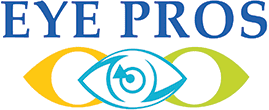Should You Use Dark Mode? Exploring the Benefits for Your Eyes
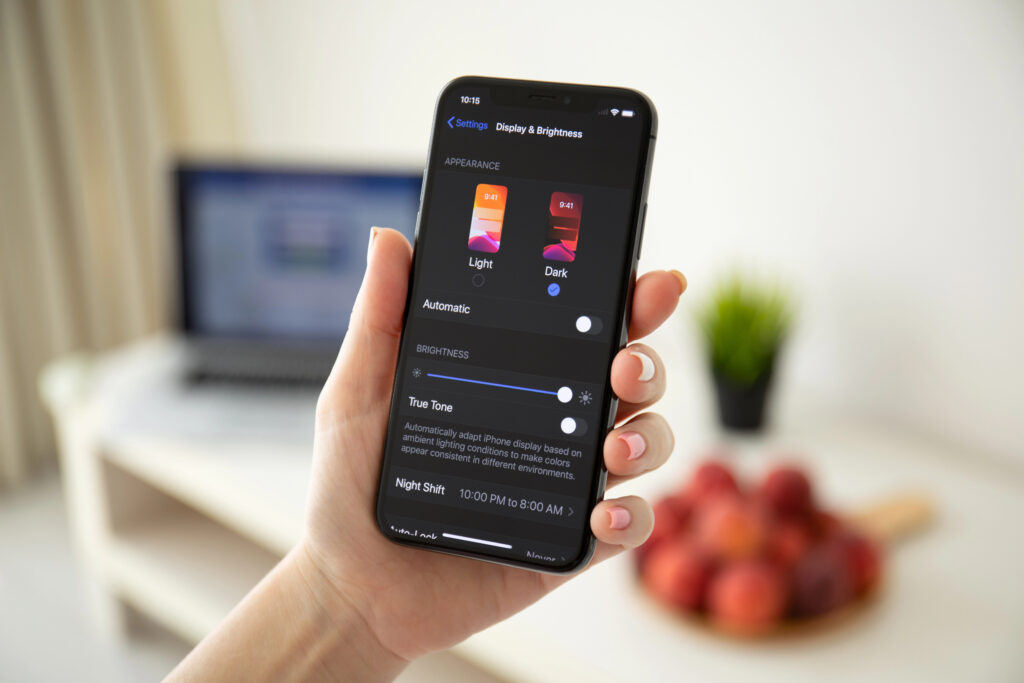
With more people using digital devices throughout the day, dark mode has quickly become a popular screen setting. The feature, available on most devices, switches the traditional white background to black, with lighter text, offering a more subdued viewing experience. But the question remains: is dark mode better for your eyes? Dark mode may indeed benefit eye comfort, especially for those who spend hours working in dim environments. For many, it’s a way to reduce eye strain, limit blue light exposure, and even improve sleep. However, it’s not necessarily the best choice for everyone or for all situations. In this article, we’ll break down the benefits and potential downsides of dark mode, as well as tips for using it effectively to help you make the best choice for your eye health. If you’re unsure, a consultation with an eye doctor from Eye Pros can provide personalized recommendations based on your specific needs. Benefits of Using Dark Mode for Eye Health For those who spend hours on screens, dark mode can provide several eye comfort benefits, especially in low-light settings. Reasons dark mode may be easier on your eyes: Reduced Eye Strain The softer, darker background can reduce the glare from screens, making it less taxing on the eyes, especially in dim environments. For people who work at night or in low-light conditions, dark mode can help limit the contrast between screen and surroundings, easing eye strain. Lower Blue Light Exposure Blue light from screens can contribute to digital eye strain and interfere with sleep. Dark mode reduces overall screen brightness, lowering the amount of blue light emitted. Although it’s not a complete substitute for blue light filters, dark mode can be an additional tool to minimize blue light exposure in the evening. Increased Comfort in Dimly Lit Rooms In dark environments, a bright white screen can feel harsh on the eyes. Dark mode provides a more natural viewing experience for such settings, reducing the need for your eyes to constantly adjust to the contrast between screen and room lighting. While dark mode can be a helpful feature, it’s not a cure-all for eye strain or discomfort. For more tailored advice on managing screen-related discomfort, our eye doctor can offer personalized solutions, including blue light filters and screen adjustment tips based on your specific needs. When Dark Mode May Not Be the Best Choice Although dark mode has its advantages, it’s not ideal for everyone or every situation. Scenarios where dark mode may not be ideal: Difficulty in Bright Settings Dark mode may cause text to appear less clear in brightly lit environments. The reduced contrast can make it harder to read, leading to additional eye strain as your eyes try to adjust. In such settings, light mode is often more comfortable. Visual Clarity for People with Astigmatism People with astigmatism may experience more difficulty with dark mode due to reduced contrast, leading to blurred or haloed vision. The lower light levels can also cause the pupils to dilate, increasing the effects of visual distortions, especially in low lighting. While dark mode offers comfort for certain environments, it’s not always the best choice. Consulting with an eye doctor at Eye Pros can provide you with guidance on screen settings, especially if you have specific vision concerns like astigmatism or experience discomfort during extended screen use. Practical Tips for Using Dark Mode Effectively If you’ve decided to try dark mode but want to ensure it’s benefiting your eye health, consider these practical tips. Practical tips to get the most out of dark mode: Adjust Based on Time of Day Dark mode works best in dim or low-light environments, especially at night. During the day, switching back to light mode may reduce eye strain and improve text clarity in bright settings. Combine with Blue Light Filters Dark mode reduces overall brightness, but a blue light filter can add extra protection. Many devices have a “night shift” or “blue light filter” mode that can work alongside dark mode to further limit blue light exposure and support eye comfort. Fine-Tune Brightness Keep your screen brightness adjusted to match your surroundings. A screen that’s too bright or too dim can still lead to eye strain, so make sure to tweak brightness levels to suit your environment. Limit Screen Time While dark mode can help reduce eye strain, limiting screen time is one of the most effective ways to protect your eyes. Taking regular breaks using the 20-20-20 rule (look at something 20 feet away for 20 seconds every 20 minutes) is a simple yet powerful habit. Using dark mode thoughtfully, especially in combination with these strategies, can help you find a comfortable balance for screen use. FAQs Is dark mode healthier for eyes? Dark mode can be gentler on the eyes in low-light environments by reducing glare and screen brightness. However, its health benefits vary from person to person, and it may not be ideal for everyone. Consulting an eye doctor can provide personalized advice on whether dark mode is suitable for your eyes. Which is better, dark or light mode? The choice between dark and light mode depends on your environment and personal comfort. Dark mode works well in dim settings, while light mode is generally more comfortable in bright environments. An eye doctor can help you find the best screen settings based on your vision needs. Is there a benefit to dark mode? Yes, dark mode offers several benefits, including reduced glare, decreased blue light exposure, and increased comfort in low-light settings. It may also reduce eye strain for some people, particularly during nighttime use. Is light or dark mode better for astigmatism? People with astigmatism may find light mode clearer and easier to read due to the improved contrast, especially in bright environments. Dark mode can sometimes cause blurriness or halos for those with astigmatism, so experimenting with both settings is recommended. Does dark mode reduce eye strain? Dark mode can help reduce eye strain in low-light environments by lowering brightness and
All About Multifocal Lenses: Are They Right for You?
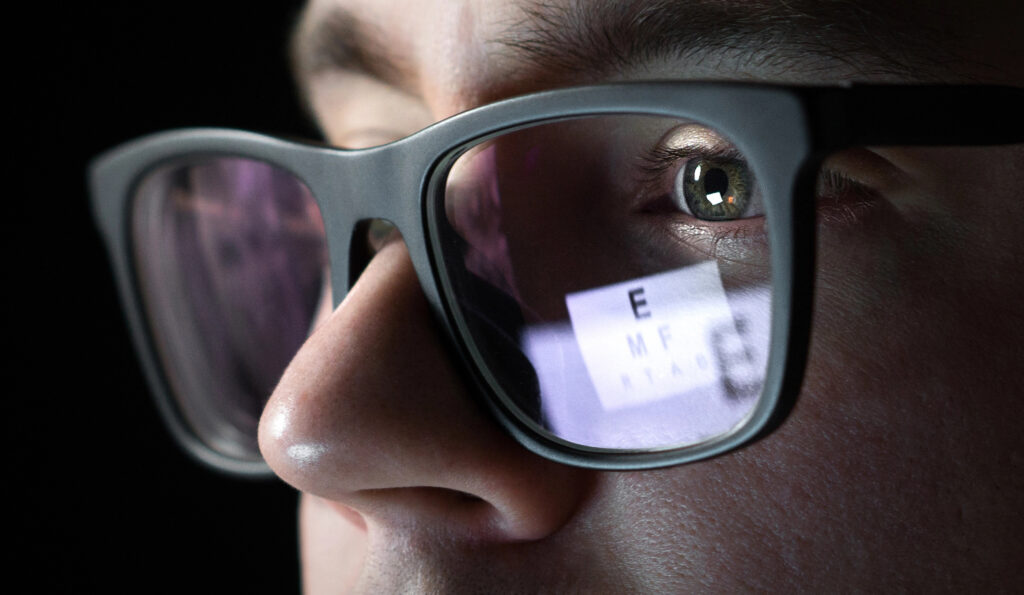
As we get older, it’s common to experience changes in vision, especially when it comes to seeing things up close. This condition, known as presbyopia, affects many people over the age of 40 and can make reading, using a phone, or even seeing small print challenging. For those tired of switching between reading glasses and regular glasses, multifocal lenses offer an all-in-one solution. Multifocal lenses are designed to provide clear vision at multiple distances—near, far, and everything in between. Available as both contact lenses and eyeglasses, they’re an increasingly popular option for people looking to streamline their vision correction. Wondering if they’re right for you? Consulting with an eye doctor can help you determine whether multifocal lenses fit your lifestyle and vision needs. In this article, we’ll explore how multifocal lenses work, their types, benefits, and what to expect if you decide to make the switch. What Are Multifocal Lenses and How Do They Work? Multifocal lenses are specially designed to correct vision at multiple distances, making them ideal for people who need help seeing both near and far. Unlike single-vision lenses that correct just one range, multifocals allow a seamless transition between near, intermediate, and distant vision, all within a single lens. This feature makes them especially valuable for individuals with presbyopia, where close-up vision becomes more difficult with age. Multifocal lenses work by incorporating different prescriptions within the same lens, so your eyes can naturally shift focus without needing to swap glasses or strain your vision. These lenses come in various designs, such as progressive lenses in eyeglasses, which have a gradual shift from one prescription to another, eliminating the “line” that traditional bifocals have. An eye doctor can help explain the specific multifocal lens designs and recommend the best option based on your lifestyle and daily visual needs. Whether you choose multifocal glasses or contact lenses, these lenses can make a huge difference in the ease and comfort of your everyday vision. Types of Multifocal Lenses When it comes to multifocal lenses, there are several options available, allowing you to choose the type that best suits your lifestyle and vision needs. Here are the main types: Multifocal Contact Lenses These come in soft and rigid (gas-permeable) forms. Soft multifocal contacts are often preferred for their comfort, while rigid lenses can provide sharper vision in some cases. They’re available in daily, bi-weekly, or monthly disposables, giving you flexibility based on your wear preferences. Progressive Eyeglass Lenses A popular choice, progressive lenses provide a gradual transition from distance to near vision without visible lines, unlike bifocals or trifocals. This creates a more natural visual experience for those needing help with both close-up and distant tasks. Bifocal and Trifocal Eyeglass Lenses While not technically “multifocal,” bifocals and trifocals offer two or three focal points, respectively, with visible lines on the lens. These may be suitable for those who only need specific focal adjustments and don’t mind the distinct sections on the lenses. Consulting an eye doctor can help you decide which type of multifocal lens is best based on factors like comfort, appearance, and how frequently you need near or distance vision. Each type offers unique benefits, and with the right choice, you can enjoy smooth vision correction for all your activities. Benefits and Drawbacks of Multifocal Lenses Multifocal lenses offer a convenient solution for those who want clear vision at multiple distances without the hassle of switching glasses. However, like any vision correction option, they come with both advantages and potential downsides. Benefits of Multifocal Lenses Convenient Vision Correction: Multifocal lenses allow you to see clearly at different distances—near, intermediate, and far—without needing separate pairs of glasses. Natural Transition: Progressive multifocal lenses provide a gradual shift between focal points, creating a smooth and natural visual experience without the sharp “jump” of traditional bifocals. Reduced Need for Multiple Glasses: With multifocal lenses, you won’t need to carry around reading glasses or switch between different pairs throughout the day. Drawbacks of Multifocal Lenses Adjustment Period: Some people experience a learning curve when adjusting to multifocal lenses, especially progressive lenses, as their eyes get used to the multiple focal areas. Visual Disturbances: Issues like glare, halos, or slight blurriness may occur, especially when first wearing the lenses or in low-light settings. Higher Cost: Multifocal lenses, particularly progressives and multifocal contacts, tend to be more expensive than single-vision lenses. An eye doctor can help you weigh these pros and cons and determine whether multifocal lenses align with your lifestyle and vision needs. While they’re not ideal for everyone, many people find the convenience and clarity multifocals offer well worth the investment. Are Multifocal Lenses Right for You? Deciding whether multifocal lenses are the right choice depends on your lifestyle, vision needs, and comfort preferences. Factors to consider for a good fit: You Have Presbyopia: Multifocals allow you to see clearly at various distances without needing multiple pairs of glasses, making them ideal for those with busy, varied lifestyles. You’re Comfortable with a Brief Adjustment Period: Some users experience a short adjustment period as they get used to the different focal points within the lenses. If you’re open to this initial adaptation, the lenses can provide lasting visual benefits. Budget Considerations: Multifocal lenses, especially progressive lenses, can be pricier than single-vision options. However, many people find the convenience worth the cost. Consult an Eye Doctor: An eye doctor can assess your specific vision requirements, discuss different types of multifocal lenses, and help you determine if they’re the right option. They may even recommend trial lenses to see how well you adapt. Choosing multifocal lenses can simplify your vision correction routine and enhance your overall experience with clearer, more flexible sight. If you’re considering the switch, an eye doctor can guide you toward the best choice based on your needs. Adjusting to Multifocal Lenses: Tips and Expectations Switching to multifocal lenses can be a game-changer for clear vision at all distances, but it often requires a short adjustment period. Getting accustomed to the different
What to Expect During Your First Contact Lens Fitting
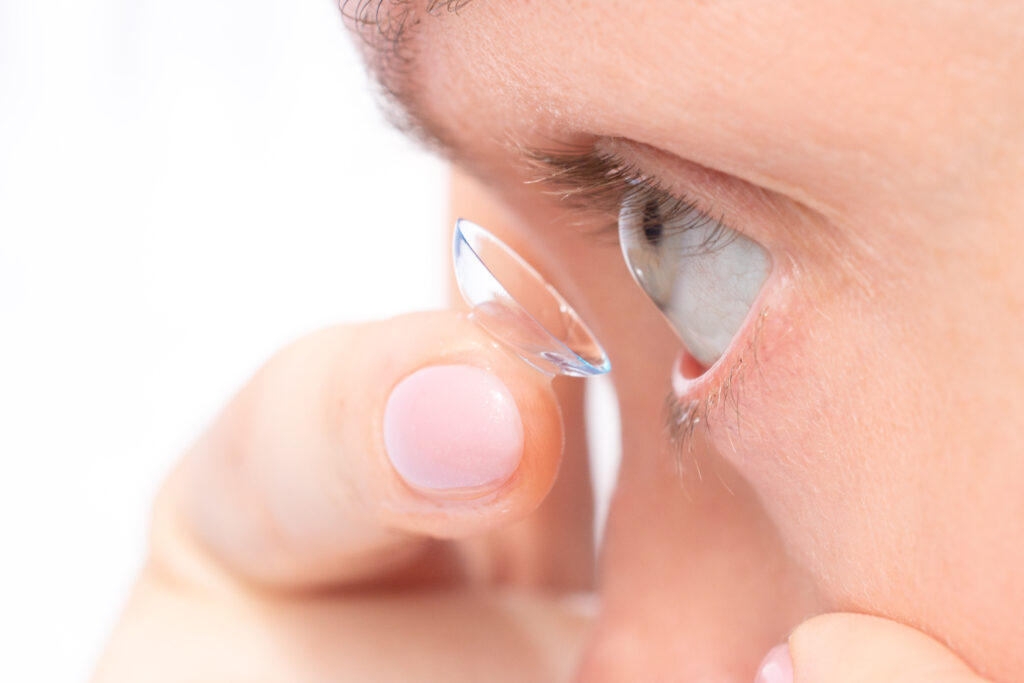
Thinking about switching to contact lenses? Your first contact lens fitting is an exciting step, and it’s all about finding the perfect lenses that fit comfortably and suit your lifestyle. During this appointment, an eye doctor will ensure your lenses provide clear vision and feel great throughout the day. From choosing the right lens type to learning how to handle and care for your contacts, a fitting session helps you feel confident with your new lenses. The process is straightforward and includes a comprehensive eye exam, lens fitting, and guidance on wearing and caring for your lenses. Here’s what to expect from start to finish, so you can approach your first fitting with ease and excitement. Steps in the Contact Lens Fitting Process During your first contact lens fitting, the eye doctor will walk you through several steps to ensure your lenses are comfortable, effective, and tailored to your specific needs: Comprehensive Eye Exam: The fitting begins with a full eye exam to assess your overall eye health and determine your prescription. This step is crucial, as contact lens prescriptions differ slightly from eyeglass prescriptions. Corneal Measurements: The curvature of your cornea (the front surface of the eye) is measured to ensure the lenses fit well and stay in place. Proper measurements help prevent discomfort or movement of the lenses. Tear Film Evaluation: The doctor may evaluate your tear production, as adequate tear film is essential for comfortable lens wear. If you have dry eyes, specific lens materials might be recommended to improve moisture retention. Lens Selection: Based on the exam and measurements, the eye doctor will recommend the most suitable type of lens, whether daily disposables, extended wear, or lenses for specific needs like astigmatism. Each of these steps ensures that the lenses chosen are comfortable and compatible with your vision and lifestyle. By the end of this process, you’ll be ready to try out a pair of trial lenses to confirm the fit. Trying Out Trial Lenses Once the initial measurements and exams are complete, it’s time to try on a pair of trial lenses. These lenses allow you and your eye doctor to evaluate the fit, comfort, and clarity they provide. During this stage, the doctor will make sure the lenses sit properly on your eyes and that you’re seeing clearly at various distances. During trial lenses, your eye doctor will check for: Proper Fit: Ensuring the lenses align well with the natural shape of your eyes, without shifting or causing discomfort. Comfort: Confirming that the lenses feel comfortable and don’t cause dryness, irritation, or foreign body sensation. Clarity of Vision: Assessing how clearly you can see with the lenses in, and making any adjustments if needed to achieve optimal vision. This step is crucial for making sure the lenses will perform well in your daily life. Your eye doctor may adjust the lens type or fit based on this trial if necessary, ensuring you’re fully satisfied before you leave the office. Learning to Insert, Remove, and Care for Lenses After finding the right fit with your trial lenses, your eye doctor or a technician will guide you through the essential steps of inserting, removing, and caring for your lenses. This hands-on instruction is designed to help you feel confident and comfortable handling your contacts. Here’s what you’ll learn: Inserting Your Lenses: You’ll be shown the correct technique for placing the lenses on your eyes, including tips to keep your eyes moist and reduce any initial discomfort. Removing Your Lenses: The doctor or technician will teach you a safe and gentle way to remove the lenses, making sure you know how to avoid touching your eyes directly. Cleaning and Storage: Proper cleaning is vital for lens hygiene and eye health. You’ll learn how to clean your lenses daily (if not using disposables), and the best way to store them to prevent infections. Lens Wear Schedule: Based on your lens type, the eye doctor will recommend how long you should wear them each day, especially in the beginning, to allow your eyes to adapt gradually. Getting comfortable with inserting, removing, and caring for your lenses is essential for maintaining eye health and ensuring your contacts remain comfortable. If you have questions or face any issues, your eye doctor is there to provide support and guidance. Follow-Up Appointment and Adjustment Period After your initial fitting, your eye doctor may schedule a follow-up appointment to check how well your eyes are adapting to the lenses and to address any concerns you might have. This appointment typically takes place a week or so after your fitting and is an opportunity to ensure the lenses continue to fit comfortably and provide clear vision. What to Expect During the Adjustment Period: Adaption to Wear Time: You may be advised to wear your lenses for shorter periods initially and gradually increase the duration as your eyes get used to them. Monitor for Any Discomfort: If you experience any dryness, blurriness, or irritation, be sure to note when and under what conditions it happens. Your eye doctor can suggest solutions or adjustments to improve comfort. Fine-Tuning the Fit: In some cases, minor adjustments to the lens type or fit might be made during this follow-up to optimize comfort and clarity. The follow-up appointment is a chance to discuss any challenges you’ve encountered and to ensure you’re fully comfortable with your new lenses. Your eye doctor will be your partner in this process, making adjustments as needed so you can enjoy clear, comfortable vision with your contacts. FAQs What is a contact lens fitting? A contact lens fitting is an appointment where an eye doctor determines the best type and fit of contact lenses for your eyes. The process includes a comprehensive eye exam, corneal measurements, and a trial fitting to ensure the lenses provide comfort and clear vision. How to tell if contacts fit properly? Properly fitted contacts should feel comfortable and stay in place without shifting. If you experience consistent discomfort, irritation, or
How to Transition from Glasses to Contact Lenses Comfortably
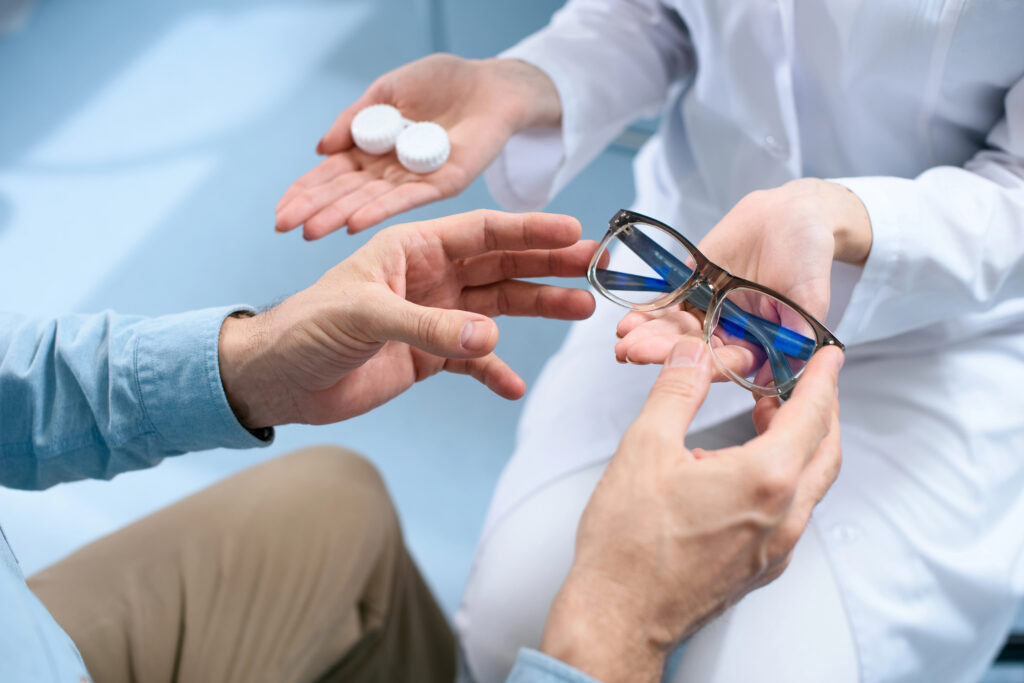
Switching from glasses to contact lenses opens up a world of convenience, comfort, and freedom, but making the transition smoothly requires a bit of preparation and patience. Contact lenses offer several advantages over glasses, including a wider field of vision and flexibility for active lifestyles. However, as with any change, adapting to contact lenses takes time and the right guidance. Working with an eye doctor is essential when transitioning to contact lenses for the first time. A personalized fitting, a review of lens options, and tips for a comfortable adjustment period are all part of a successful switch. By taking the right steps and knowing what to expect, you can enjoy the benefits of contact lenses without the discomfort or uncertainty that new users sometimes experience. Let’s explore how to make this transition as comfortable and seamless as possible. Preparing for Contact Lenses Making the shift from glasses to contact lenses requires a bit of preparation to ensure the most comfortable experience possible. Starting with a fitting and consultation with an eye doctor can make a significant difference, as they’ll help you find the best lenses for your eyes and lifestyle. Steps to prepare for contact lenses: Schedule a Contact Lens Fitting A proper fitting with an eye doctor is crucial for comfort and clear vision. They’ll determine the right type of contact lens based on your prescription and eye shape. Understand Your Prescription and Lens Options Contact lenses come in various materials, designs, and wear schedules (like daily or monthly). Your eye doctor can recommend the best option for your needs, whether it’s for occasional wear or full-time use. Set a Realistic Expectations It’s normal for contact lenses to feel slightly unfamiliar at first. Understanding that there may be an adjustment period can help ease the transition and keep you motivated to stick with it. With the support of an eye doctor, these preparatory steps can help you start your contact lens journey with confidence and set the foundation for a comfortable experience. Tips for Comfortable Transition Adjusting to contact lenses doesn’t have to be uncomfortable. By taking gradual steps and following a few key tips, you can make the transition from glasses to contact lenses much smoother. Here’s how to ease into wearing contacts comfortably: Start Slowly: Begin by wearing your contact lenses for just a few hours a day, gradually increasing the time as your eyes adjust. This approach allows your eyes to adapt without overdoing it. Prioritize Hygiene: Always wash your hands with soap and water before handling your lenses to prevent eye infections. Cleanliness is crucial for maintaining comfort and eye health as you adjust. Use Lubricating Drops: Contact lenses can sometimes cause dryness, especially during the adjustment period. Lubricating drops, recommended by your eye doctor, help keep your eyes moisturized and comfortable. Stay Hydrated: Drinking plenty of water throughout the day supports eye hydration, which is beneficial when adapting to contact lenses, particularly in dry or air-conditioned environments. Blink Regularly: Many people blink less frequently when using screens, which can lead to dryness with contact lenses. Blinking more often can help keep your eyes moist, especially during screen-heavy activities. These tips, along with regular check-ins with your eye doctor, can ensure a comfortable experience as you make the switch from glasses to contacts. Taking it slow and focusing on eye care will set you up for success. Benefits of Contact Lenses over Glasses Switching from glasses to contact lenses can offer various advantages, from convenience to enhanced vision quality. For those leading active lifestyles, contact lenses are often more practical and comfortable than glasses. Here are some key benefits of making the switch: Wider Field of Vision: Unlike glasses, which only correct vision within the frame, contact lenses provide clear peripheral vision, making them ideal for sports, driving, and daily activities. No Obstruction or Fogging: Contact lenses eliminate the issues of fogging up or slipping, especially in humid or rainy conditions. This makes contacts a great choice for people who spend time outdoors or exercise frequently. Natural Appearance: Contact lenses allow you to maintain your natural appearance without frames. They’re also compatible with most types of sunglasses, providing flexibility for different looks and preferences. Comfort and Stability: With a proper fit from an eye doctor, contact lenses stay stable on your eye, providing consistent vision correction without the shifting that can happen with glasses. Freedom to Choose Colored Contacts: For those interested in changing their eye color, contact lenses offer that flexibility. Colored contacts are available for vision correction, allowing for both style and function. Consulting with an eye doctor can help ensure that your contact lenses fit comfortably and provide all these benefits, allowing you to enjoy the freedom and flexibility that contacts offer over traditional glasses. Eye Care and Maintenance for New Contact Lens Wearers Taking proper care of your contact lenses is essential, especially as you transition from glasses. Good hygiene and maintenance practices help ensure clear vision, comfort, and long-term eye health. Here are some important tips for new contact lens wearers: Follow the Replacement Schedule: Different lenses have different replacement schedules (daily, biweekly, monthly). Stick to the schedule recommended by your eye doctor to avoid discomfort and risk of infection. Clean Lenses Properly: Use fresh contact lens solution each time you clean and store your lenses. Avoid reusing or topping off old solutions, as it can lead to contamination and discomfort. Avoid Sleeping in Contacts: Unless prescribed for extended wear by your eye doctor, avoid sleeping in contact lenses, as this can increase the risk of infection and dryness. Keep Lenses Moist: Use rewetting drops throughout the day if your eyes feel dry, especially if you’re spending time on screens or in air-conditioned spaces. Replace Your Lens Case Regularly: To reduce the risk of bacterial buildup, replace your lens case every few months and rinse it with fresh solution (not water) after each use. Routine follow-ups with your eye doctor help ensure your lenses continue to fit comfortably
Preventive Eye Care: How to Catch Vision Problems Early
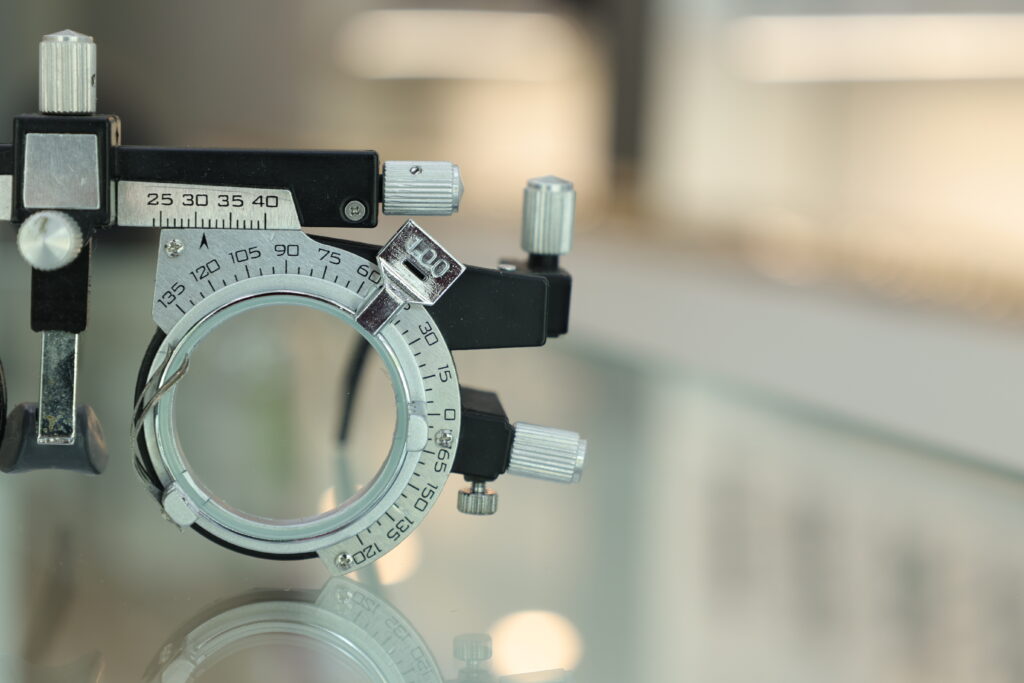
Your vision is one of your most important senses, and protecting it should be a priority—especially as you age. Preventive eye care is all about catching vision problems early, often before you even notice symptoms. By being proactive and getting regular eye exams, you can address issues like cataracts, glaucoma, or macular degeneration before they cause lasting damage. The best part? It doesn’t take much to keep your eyes in great shape. In this guide, we’ll show you how a few simple habits, along with the help of your eye doctor, can help you stop vision loss before it starts. From routine eye exams to adopting the right lifestyle choices, catching problems early is key to maintaining healthy vision for life. Why Preventive Eye Care is Important Preventive eye care is your first line of defense against serious vision problems. Many common eye conditions, like cataracts, glaucoma, and macular degeneration, develop slowly and often without noticeable symptoms in the early stages. By the time these issues affect your daily life, significant vision loss may already have occurred. That’s why early detection is so crucial—catching problems early can stop vision loss before it becomes permanent. Regular visits to your eye doctor help ensure that your eyes are thoroughly examined, allowing any potential issues to be identified and treated early. In addition to routine eye exams, simple lifestyle changes—like wearing sunglasses, eating eye health foods, and managing screen time—can go a long way toward protecting your vision. Preventive care not only helps prevent vision loss, but it also reduces the need for invasive treatments later on. Think of it as taking small steps now to protect your sight for the long run. The earlier you start, the better your chances of maintaining clear vision. Can Vision Problems That Can Be Detected Early Routine eye exams are essential for catching vision problems before they worsen. Many serious eye conditions can be detected early and treated effectively with the help of your eye doctor. Here are a few of the most common vision problems that preventive care can identify: Cataracts These develop gradually and cause the lens of your eye to become cloudy, leading to blurry vision and difficulty seeing at night. Early detection allows for timely treatment, such as surgery, to restore clear vision. Glaucoma Known as the “silent thief of sight,” glaucoma often shows no early symptoms, but it can cause irreversible damage to the optic nerve if left untreated. Routine exams can catch glaucoma in its early stages, preventing serious vision loss. Macular Degeneration This condition affects central vision, making tasks like reading or recognizing faces difficult. Early detection is critical to slowing its progression, and your eye doctor can recommend treatments to manage the condition. Diabetic Retinopathy If you have diabetes, this condition can damage the blood vessels in your retina, leading to vision problems. Preventive eye exams can detect diabetic retinopathy early and help stop vision loss before it becomes severe. Catching these conditions early through preventive eye care can help you stop vision loss now and maintain healthy vision for years to come. The Role of Routine Eye Exams in Preventive Care Routine eye exams are one of the most effective ways to protect your vision and catch problems before they progress. Seeing your eye doctor regularly allows for early detection of common conditions like glaucoma, cataracts, and macular degeneration, all of which can lead to permanent vision loss if not treated in time. But how often should you get an eye exam? Adults under 40 should have an eye exam every two years to monitor overall eye health. Adults over 40 or those at higher risk of eye diseases, such as people with diabetes, should see their eye doctor annually for more frequent checkups. Seniors over 60 are particularly prone to age-related eye conditions and should get comprehensive exams once a year. Routine eye exams do more than just check for prescription updates—they’re essential for catching early signs of serious conditions. Your eye doctor will use diagnostic tools and imaging to ensure your eyes are healthy, which can ultimately prevent vision loss and stop issues from escalating. By keeping up with regular eye checkups, you can take control of your vision health and stop vision loss before it starts. Technology and Techniques for Early Detection Thanks to advancements in technology, early detection of vision problems has become more precise and effective. During routine checkups, your eye doctor can use a variety of tools and techniques to identify potential issues before they become serious. Here are some key methods used for early detection: Retinal Imaging This technology allows your eye doctor to take detailed images of the back of your eye, making it easier to detect early signs of conditions like diabetic retinopathy and macular degeneration. Optical Coherence Tomography (OCT) OCT is a non-invasive imaging technique that provides cross-sectional images of the retina. This advanced tool helps detect conditions like glaucoma and macular degeneration at an early stage, even before symptoms appear. Tonometry This test measures the pressure inside your eye and is crucial for detecting glaucoma early. Elevated eye pressure is often the first sign of glaucoma, and catching it early can help prevent vision loss. Vision Screening Simple vision screening tests can detect refractive errors like nearsightedness or farsightedness. Early correction with glasses or contact lenses can stop further strain on your eyes. By using these technologies during your routine exam, your eye doctor can catch vision problems early and recommend the right treatment to help you maintain healthy eyes. Early detection not only helps prevent vision loss but also saves you from more invasive procedures later on. Preventing Lifestyle Habits to Protect Vision While regular visits to your eye doctor are essential, you can also take proactive steps in your daily life to protect your vision and prevent future problems. Incorporating simple lifestyle changes can make a significant difference in maintaining healthy eyes. Here are some key habits to adopt: Eat Eye-Healthy Food Your
How Eye Exams Change as You Age: From Kids to Seniors
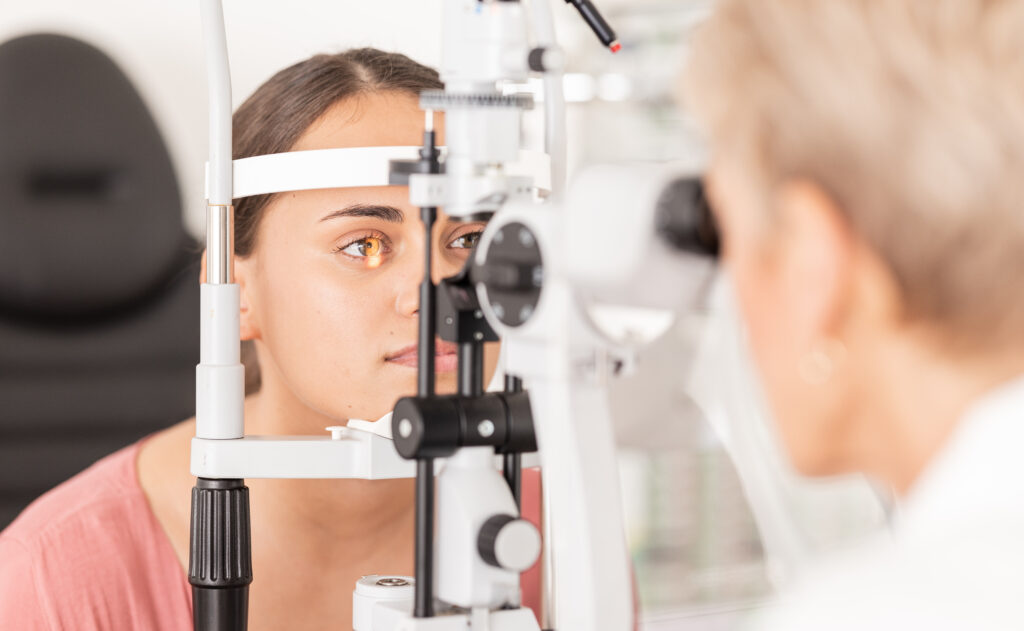
As we grow and age, our bodies change—and so do our eyes. From childhood to senior years, vision needs evolve, and regular eye exams are the key to keeping your eyes healthy at every stage of life. But did you know that the way your eye doctor checks your eyes also changes depending on your age? Whether it’s a child’s first eye exam, an adult dealing with digital eye strain, or a senior monitoring for cataracts, regular visits to the eye doctor ensure that you catch any issues early and protect your vision over time. In this article, we’ll explore how eye exams shift through different life stages, so you know what to expect as you and your eyes age. Eye Exam for Kids Children’s vision develops rapidly in the early years, and regular eye exams are essential for ensuring their eyesight is on the right track. Detecting vision problems early can prevent long-term issues that may affect learning and development. Most parents are unaware that kids can have vision problems even before they complain about blurry vision or other symptoms. That’s why an eye doctor plays a key role in catching problems that might go unnoticed. Here’s why early eye exams are so important for children: Detecting common vision problems: Issues like lazy eye (amblyopia), crossed eyes (strabismus), or refractive errors (nearsightedness, farsightedness) are more easily treated when caught early. First eye exams: It’s recommended that children have their first comprehensive eye exam around the age of 3, or earlier if there are signs of vision issues. After that, regular exams are important to monitor their development. Visual learning: Since much of a child’s learning is visual, poor eyesight can lead to struggles in school. Kids may not realize their vision is blurry, which makes regular exams essential. By bringing your child to an eye doctor for regular check-ups, you can ensure that any vision problems are detected and treated early, giving your child the best start in life. Eye Exams for Teens and Young Adults As kids grow into their teenage years and young adulthood, their vision can still change significantly, especially with the increased use of digital devices. This is the age group most prone to digital eye strain, a condition caused by long hours spent in front of screens for school, work, or entertainment. Regular visits to an eye doctor during this stage are crucial to monitor vision changes and catch any developing issues early. Here’s why eye exams are important for teens and young adults: Screen time and digital eye strain: With so much time spent on phones, tablets, and computers, teens and young adults are more likely to experience digital eye strain. Symptoms include headaches, blurry vision, and dry eyes. An eye doctor can recommend strategies to reduce these symptoms, such as blue light filtering glasses or proper screen breaks. Changes in vision: For many young adults, vision problems like nearsightedness or farsightedness can become more apparent during these years. Teens may also need glasses or contact lenses to correct vision for driving, reading, or schoolwork. Sports and eye protection: For active teens, eye exams can also ensure that they have the right protective eyewear for sports. Whether it’s prescription goggles for swimming or protective lenses for contact sports, an eye doctor can guide teens on the best way to protect their eyes. Scheduling regular eye exams ensures that vision problems are caught early and helps maintain good eye health during these pivotal years of growth and change. Eye Exams for Adults (20s to 40s) In adulthood, vision tends to stabilize, but that doesn’t mean you can skip regular eye exams. As life becomes busier with work and other responsibilities, it’s easy to overlook eye health. However, this is the age when screen time increases significantly, which can lead to digital eye strain and other vision-related issues. Routine visits to an eye doctor can help ensure your vision remains clear and healthy as you juggle work, family, and other activities. Here’s why adults in their 20s to 40s should keep up with eye exams: Refractive errors: Many adults experience vision problems like nearsightedness, farsightedness, or astigmatism during this period. Corrective lenses, such as glasses or contact lenses, can help address these issues and maintain clear vision. Digital eye strain: With so much time spent on screens, many adults experience eye strain, headaches, and blurred vision. An eye doctor can suggest solutions like blue light lenses, proper screen settings, and taking breaks to reduce discomfort. Early detection of eye conditions: Regular eye exams can also catch early signs of more serious conditions, such as glaucoma, even if you aren’t noticing symptoms yet. Early detection is key to preventing vision loss. Contact lens care: For adults who wear contact lenses, eye exams ensure the lenses fit well and provide the correct vision correction. Poorly fitting lenses can lead to infections or discomfort, so it’s important to keep your prescription up to date. By maintaining regular eye exams, adults can protect their vision and catch any issues before they become more serious. Eye Exams for Middle-Aged Adults (40s to 60s) Once you reach your 40s, you might notice that your vision isn’t what it used to be. This is the stage of life where presbyopia—the age-related difficulty of seeing things up close—starts to set in. Whether you’re struggling to read fine print or finding it harder to focus on near objects, regular visits to an eye doctor become essential. Changes in vision are normal as you age, but an eye exam can ensure you get the right corrective lenses and detect any early signs of eye conditions. Here’s why eye exams in your 40s and 50s are so important: Presbyopia: This common condition makes reading or seeing things up close more difficult. Many people begin using reading glasses or multifocal lenses during this time, as recommended by their eye doctor. Increased risk of eye diseases: As you age, the risk of developing eye conditions like glaucoma,
How Often Should You Renew Your Contact Lens Prescription?
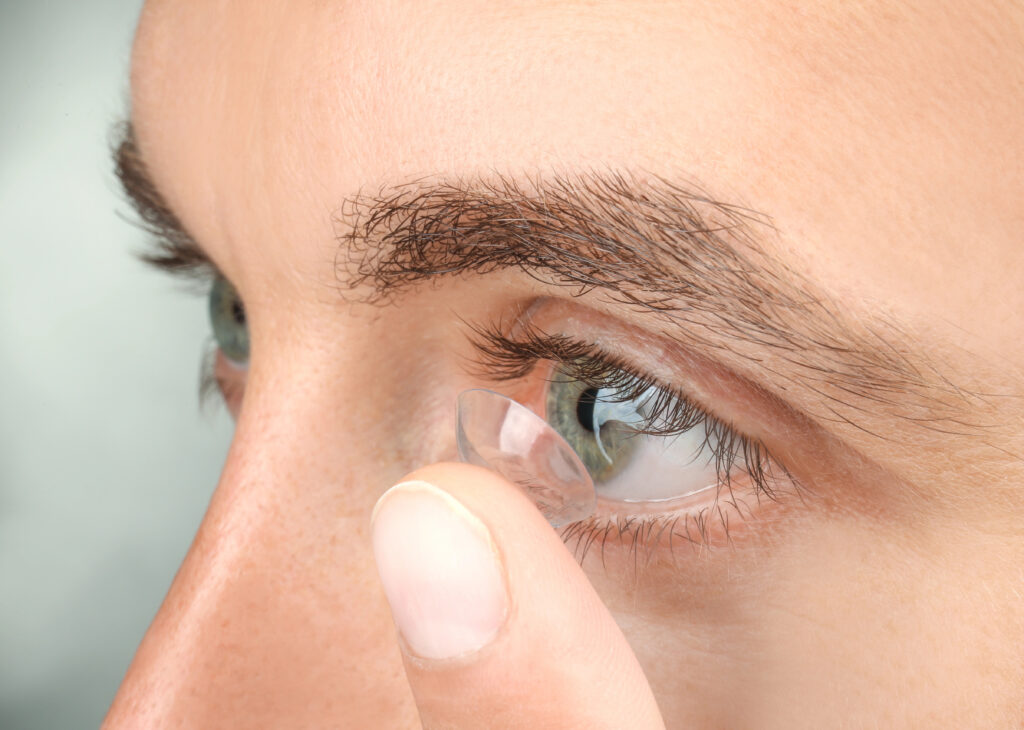
If you wear contact lenses, keeping your prescription up to date is crucial for maintaining both clear vision and eye health. Many people overlook the importance of renewing their contact lens prescription regularly, but doing so ensures your lenses fit properly, correct your vision accurately, and don’t cause unnecessary strain or discomfort. A simple visit to your eye doctor for a contact lens prescription test can make all the difference in protecting your long-term eye health. In this article, we’ll explore how often you should renew your prescription, why regular eye exams are essential, and the potential risks of using an outdated prescription. Staying informed and proactive can help you avoid vision problems and keep your eyes healthy while wearing contact lenses. How Often Should You Renew Your Contact Lens Prescription? It’s recommended to renew your contact lens prescription every 1 to 2 years, depending on your individual needs and the guidelines set by your eye doctor. The expiration date on your prescription ensures that you’re using lenses that fit properly and reflect any changes in your vision. Over time, your eyes can change shape or develop conditions that affect how your lenses fit and perform, which is why it’s important to keep your prescription updated. Here’s why renewing your contact lens prescription regularly is essential: Vision Changes Your vision can change subtly over time, even if you don’t notice it right away. An outdated prescription can cause eye strain, blurred vision, or headaches. Eye Health Monitoring Regular eye exams are not just for checking your vision—they allow your eye doctor to monitor the overall health of your eyes, including checking for conditions like dry eyes or corneal damage, which can be worsened by contact lens use. Prescription Expiration By law, contact lens prescriptions typically expire after one year, sometimes two, depending on where you live. This is to ensure that you’re consistently using lenses that are safe and effective for your current eye condition. Renewing your contact lens prescription on time ensures that your lenses are comfortable and effective, while helping you avoid unnecessary risks. Scheduling regular visits to your eye doctor for a contact lens prescription test is the best way to stay on top of your eye care needs. Why You Need Regular Eye Exams for Contact Lenses Regular eye exams are essential for contact lens wearers to ensure not only that your prescription is correct, but also that your eyes remain healthy over time. Unlike glasses, contact lenses sit directly on the surface of your eye, which makes it even more important to have your eyes checked regularly by an eye doctor. Here’s why frequent eye exams are critical for contact lens wearers: Checking for Vision Changes Your vision can change gradually, even if you don’t notice it right away. Regular eye exams ensure that your contact lens prescription is up to date and that your lenses provide optimal correction for your current vision needs. Contact Lens Fit During a contact lens prescription test, your eye doctor will ensure that your lenses fit properly. A poor fit can cause discomfort, blurred vision, and even lead to conditions like corneal abrasions or infections. Monitoring Eye Health Long-term use of contact lenses can increase the risk of dry eyes, infections, and other eye conditions. Routine exams allow your eye doctor to monitor your eye health and address any issues before they worsen. Detecting Early Signs of Problems Eye exams can catch early signs of problems that may not show symptoms yet, such as corneal damage or early-stage eye diseases. This is particularly important for contact lens wearers, as lenses can sometimes mask or worsen these conditions. Regular eye exams not only keep your prescription accurate but also ensure that your eyes remain healthy and comfortable while wearing contact lenses. A visit to your eye doctor every year or two can prevent complications and keep your vision sharp. Signs You Need to Renew Your Contact Lens Prescription It’s important to recognize when your contact lens prescription may need an update. Wearing an outdated prescription can lead to discomfort and vision issues that affect your daily life. Here are some common signs that it’s time to renew your prescription and see your eye doctor: Blurred Vision If your vision starts to get blurry while wearing your contact lenses, even after cleaning them, it may be a sign that your prescription is no longer accurate. This could lead to eye strain and headaches if not addressed. Eye Discomfort Feeling discomfort, irritation, or dryness in your eyes while wearing contact lenses can indicate that your lenses no longer fit properly or that your eye shape has changed. An updated prescription can help fix this issue. Frequent Dry Eyes If you experience dry eyes more often, even when using lubricating drops, it may be time to have your prescription reviewed. Your eye doctor can assess whether your current lenses are contributing to this condition. Headaches and Eye Strain If you’re squinting or feeling eye strain, particularly when reading or working on a computer, your current lenses may not be providing the correct vision correction. This is a sign that you need a new contact lens prescription. Changes in Lens Fit If your contact lenses feel uncomfortable or seem to shift around in your eyes, it could be a sign that they no longer fit as they should. This is another reason to schedule an appointment with your eye doctor to renew your prescription. If you notice any of these symptoms, it’s time to schedule an eye exam to ensure your prescription is accurate. A contact lens prescription test can make sure you’re wearing lenses that provide both comfort and clarity. Risk of Wearing Expired or Outdated Contact Lenses Wearing contact lenses with an expired or outdated prescription can pose significant risks to your eye health. While it may seem convenient to continue using your current lenses, ignoring the need for renewal can lead to discomfort and even long-term damage. Here are some
Quick Eye Exercises to Relieve Strain and Improve Vision
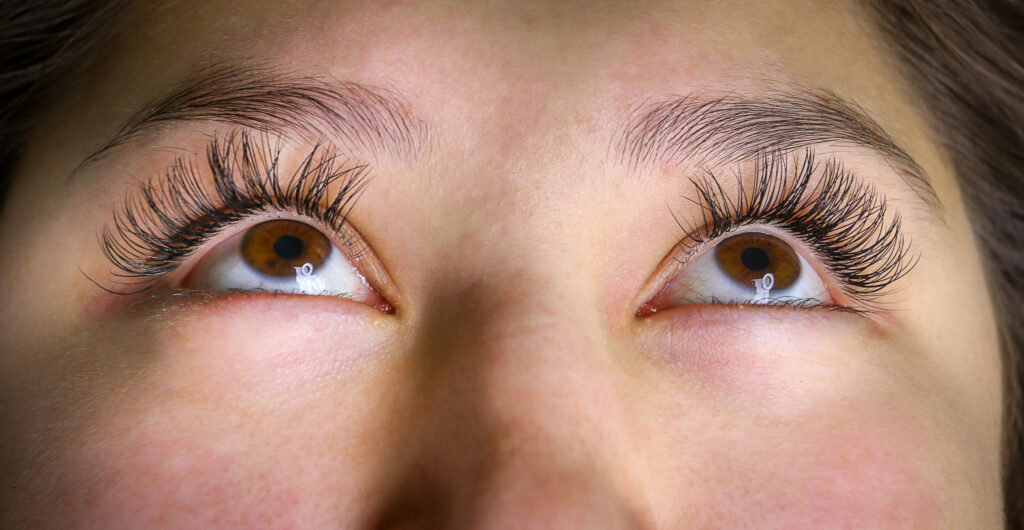
In today’s digital world, many people spend hours in front of screens, whether for work, school, or entertainment. This increased screen time often leads to uncomfortable eye strain, blurry vision, and even double vision in some cases. Thankfully, there are simple and effective eye exercises that can help relieve this strain and improve your vision naturally. These exercises don’t take much time, but they can make a big difference when incorporated into your daily routine. Whether you’re dealing with blurry vision or simply want to maintain healthy eyes, these eye exercises can support clearer vision and reduce strain. Regular eye exercises come with numerous benefits, from reducing the discomfort of staring at a screen all day to improving overall eye muscle flexibility. In this article, we’ll explore quick exercises to relieve strain and offer tips on how to keep your eyes healthy. Remember, while these exercises can improve comfort and may enhance eyesight naturally, it’s always important to visit an eye doctor for comprehensive care. For more in-depth services and personalized treatment, check out the variety of eye care services we offer at The Eye Pros. What Causes Eye Strain? Eye strain is a common issue that affects people of all ages, especially in our screen-dominated environment. Whether you’re working on a computer, using your phone, or binge-watching your favorite shows, prolonged exposure to digital devices can lead to symptoms like blurry vision, headaches, and general eye discomfort. The blue light emitted from screens, combined with a lack of regular breaks, can overwork your eye muscles and cause significant strain. Other causes of eye strain include poor lighting, reading in dim environments, and focusing on small print for long periods. Even activities like driving for extended hours or working in an office with improper lighting can contribute to eye fatigue. Over time, this strain can lead to double vision or even affect your ability to focus clearly. Incorporating eye exercises to relieve strain and improve vision is crucial, but you should also consider visiting an eye doctor to rule out any underlying conditions. Regular check-ups ensure that your eyes are in optimal health. Top 5 Quick Eye Exercises to Relieve Eye Strain and Improve Vision Incorporating quick eye exercises into your daily routine can significantly reduce eye strain, enhance focus, and even help improve blurry or double vision. Below are five simple exercises that can be done anywhere, whether you’re at work, home, or on the go. 20-20-20 Rule Instructions: Every 20 minutes, take a 20-second break and focus on something 20 feet away. Benefits: This exercise gives your eyes a much-needed break from screens, reducing strain and helping improve focus. Palming Instructions: Rub your hands together until warm and gently place them over your closed eyes for 1-2 minutes. Relax and focus on breathing. Benefits: Palming relaxes the eye muscles and relieves eye tension, promoting relaxation after long hours of use. Focus Shifting Instructions: Hold your thumb or a pen about 10 inches from your face. Focus on it, then shift your gaze to something far away (20 feet or more). Repeat 10-15 times. Benefits: This exercise strengthens focus and flexibility in your eye muscles, helping to improve eyesight. Eye Rolling Instructions: Slowly roll your eyes in a circular motion—clockwise for a few seconds, then counterclockwise. Benefits: Rolling your eyes helps ease tension in the eye muscles and can relieve strain from extended screen use. Blinking Breaks Instructions: Consciously blink more often when working on screens. Close your eyes for a few seconds and then open them again. Benefits: Blinking lubricates your eyes, prevents dryness, and can reduce strain caused by not blinking enough during screen time. These exercises are quick, easy, and can be done throughout the day to improve vision and relieve eye discomfort. While these routines can help, it’s always a good idea to consult an eye doctor for a more personalized approach to your eye health. Tips for Reducing Eye Strain Throughout the Day In addition to doing regular eye exercises, there are several simple lifestyle adjustments that can further help prevent eye strain and protect your vision. These daily habits can be particularly helpful if you spend a lot of time in front of a computer or other digital devices. Here are a few tips to consider: Adjust Your Screen Settings Make sure your screen brightness isn’t too high or too low. Ideally, it should match the brightness of your surroundings to reduce the strain on your eyes. Proper Lighting Avoid working in dimly lit environments. Proper ambient lighting reduces the contrast between your screen and the surrounding area, helping to prevent eye fatigue. Take Regular Breaks Use the 20-20-20 rule mentioned earlier. Taking regular breaks from focusing on close-up tasks can do wonders for relieving strain. Use Anti-Glare Screens If you work with digital devices all day, using anti-glare screen protectors can help reduce glare and improve your visual comfort. Stay Hydrated Drinking enough water can help keep your eyes lubricated and prevent them from drying out, which is a common cause of discomfort, especially if you wear contact lenses. These tips, when combined with eye exercises, can greatly reduce strain and support your overall eye health. If you find that you’re still struggling with consistent eye strain or other vision issues, it might be time to consult with an eye doctor. FAQs Can eye exercises improve vision? Eye exercises can help improve focus, reduce strain, and support overall eye health. While these exercises may not dramatically change your prescription, they can aid in reducing blurry vision and improving comfort, especially for people who spend a lot of time on digital screens. Which exercise is better for your eyes? The 20-20-20 rule is one of the best exercises to reduce strain from prolonged screen use. It’s simple and effective for giving your eyes a break and preventing digital eye strain. Exercises like palming and focus shifting are also great for relieving tension and improving eye flexibility. How do I make my eyes
Protecting Eye Health in Air-Conditioned Environments
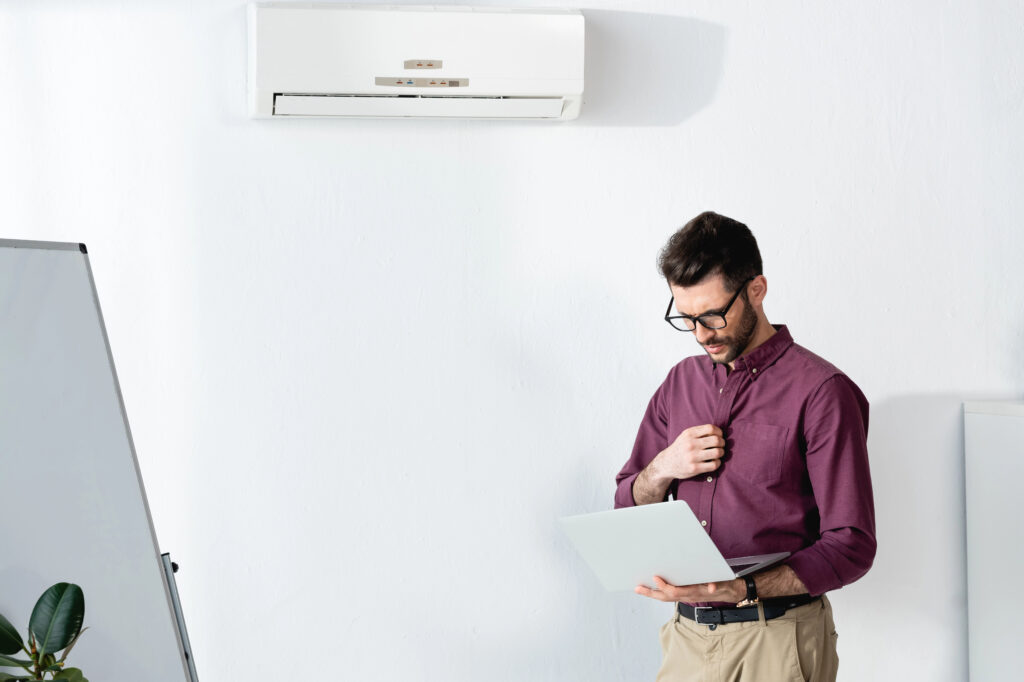
Air conditioning can be a lifesaver on hot days, but it often comes with a hidden cost: dry eyes and discomfort. By pulling moisture from the air, AC units create a cool but dry environment that can lead to eye irritation, itchiness, and even blurred vision. For those who spend long hours in air-conditioned spaces—whether at home, in the office, or even in the car—these symptoms can become an ongoing issue. Fortunately, a few simple adjustments can help keep your eyes comfortable, even in the driest indoor environments. Regular visits to an eye doctor are also essential for managing persistent dryness and identifying underlying causes. In this guide, we’ll explore how air conditioning affects your eyes and offer practical tips to protect your eye health in air-conditioned spaces. How Air Conditioning Affects Your Eyes Air conditioning works by reducing humidity, which can make the air feel refreshing but also dry. For our eyes, this lower moisture level can have some uncomfortable side effects, leading to dry eyes and irritation, particularly for those who already struggle with dryness. As the AC removes moisture from the environment, it also pulls moisture from our eyes, making it harder for them to stay naturally lubricated. Common Symptoms of AC-Related Eye Issues Dryness and Itching: Reduced moisture can cause the eyes to feel gritty or itchy. Redness and Irritation: Constant dryness can lead to redness and a stinging sensation. Blurred Vision: The lack of moisture may blur vision temporarily, especially after long hours indoors. Eye Fatigue: Staring at screens in air-conditioned rooms can worsen eye strain and lead to fatigue. If you experience any of these symptoms frequently, consulting an eye doctor can help determine whether you need additional support, such as eye drops or adjustments to your environment. Understanding how air conditioning affects your eyes is the first step in taking action to protect your vision. Tips to Protect Eye Health in Air-Conditioned Spaces Spending hours in air-conditioned environments doesn’t have to mean dealing with uncomfortable, dry eyes. With a few proactive steps, you can help maintain moisture and keep your eyes comfortable. Effective tips to protect eye health in AC-heavy spaces: Stay Hydrated: Drinking water consistently throughout the day helps keep your eyes and body hydrated, reducing dryness. Use a Humidifier: Adding a humidifier to your space can replenish moisture in the air, balancing out the drying effects of the AC. Take Blinking Breaks: Particularly if you’re staring at a screen, remember to blink often to maintain a healthy tear film. Consider following the 20-20-20 rule: every 20 minutes, look at something 20 feet away for 20 seconds. Adjust AC Settings: Lower the AC intensity or avoid sitting directly in front of vents, as direct airflow increases dryness. Regular check-ups with an eye doctor can also be helpful if you’re experiencing persistent dryness, as they can recommend personalized solutions or prescribe eye drops for additional relief. Taking small steps to protect your eyes in air-conditioned environments can make a significant difference in your comfort. Remedies and Treatments for Dry Eyes If you’re experiencing dry eyes in air-conditioned spaces, there are several remedies and treatments that can provide relief and help maintain eye moisture throughout the day. Quick solutions to soothe dry eyes: Artificial Tears: Preservative-free artificial tears can be used regularly to keep your eyes moist. They’re especially helpful in AC environments where natural tear evaporation occurs more quickly. Warm Compress: Applying a warm, damp cloth over your eyes for a few minutes helps stimulate tear production and soothes irritation, providing relief from dryness. Omega-3 Supplements: Some studies suggest that omega-3 fatty acids can improve tear quality and reduce symptoms of dry eye, making them a great addition to your diet. Eye Doctor Consultation: If over-the-counter remedies aren’t enough, an eye doctor can recommend additional treatments, such as prescription eye drops, to help manage chronic dryness. They can also evaluate for any underlying conditions that may be contributing to the issue. Using these remedies regularly can make a big difference in eye comfort, especially in dry, air-conditioned spaces. Remember that if symptoms persist, a visit to an eye doctor is the best course of action for personalized care. FAQs How to avoid dry eyes in air conditioning? To avoid dry eyes in air-conditioned environments, stay hydrated, use a humidifier, and take regular breaks to blink and refresh your eyes. Eye drops can also help maintain moisture, and sitting away from direct airflow can reduce dryness. How can I protect my eyes from dry air? Protect your eyes from dry air by using artificial tears, adding a humidifier to your space, and drinking plenty of water. If you experience persistent dryness, consult an eye doctor for personalized advice and potential treatments. Can air conditioning cause conjunctivitis? While air conditioning itself doesn’t cause conjunctivitis, it can dry out the eyes, making them more vulnerable to irritation and potential infection. If you notice redness, discharge, or persistent discomfort, see an eye doctor for evaluation. When should I see an eye doctor for dry eyes? If over-the-counter remedies don’t relieve your symptoms, or if you experience persistent irritation, blurred vision, or discomfort, it’s best to consult an eye doctor. They can recommend treatments or check for underlying issues. Why does air conditioning cause dry eyes? Air conditioning reduces indoor humidity, which dries out the air and, in turn, causes moisture to evaporate from the eyes. This effect can lead to dry, irritated eyes, especially in spaces with prolonged AC use. Air-conditioned environments can be refreshing, but they often come with the downside of dry eyes and irritation. By following simple tips—like staying hydrated, using a humidifier, and incorporating eye drops into your routine—you can protect your eyes and stay comfortable, even in the driest indoor spaces. If you’re experiencing persistent dryness or irritation despite these adjustments, it’s time to consult an eye doctor from The Eye Pros. Regular eye check-ups can help manage symptoms effectively and keep your eyes healthy in any environment. Schedule
On The Go? The Eye Pros’ Travel Eye Care Tips
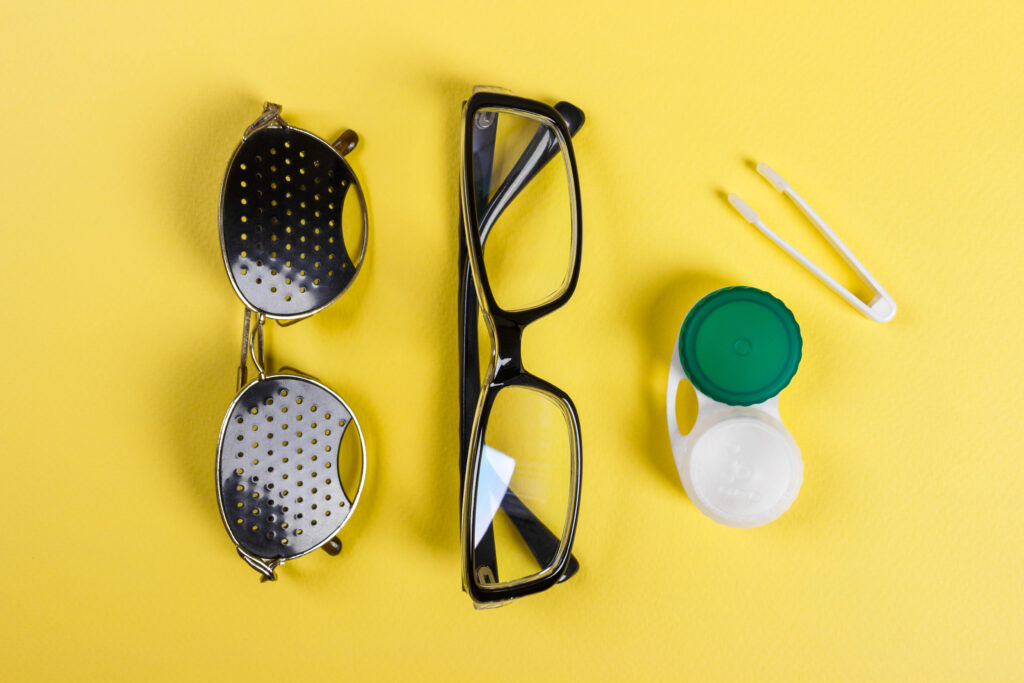
When you’re on the go, it’s easy to overlook the importance of eye care, but your eyes need attention—especially when traveling. Whether you’re taking a road trip or catching a flight, environmental changes and long journeys can affect your vision and overall eye health. From air travel with contact lenses to protecting your eyes from UV rays in new climates, keeping your eyes healthy should be a priority. At The Eye Pros, we understand that travel can put extra strain on your eyes. That’s why we’ve compiled essential travel eye care tips to help you maintain clear, comfortable vision no matter where your journey takes you. Whether you’re concerned about flying after eye surgery or simply need advice on packing a contact lens travel kit, we’ve got you covered. Common Eye Issues Travelers Face Traveling can present several challenges for your eyes, from dry air on airplanes to increased exposure to UV rays in outdoor environments. Here are some of the most common eye issues travelers encounter and how to address them. Dry Eyes Long flights and extended travel can lead to dry eyes, especially due to the low humidity in airplane cabins. The dry air reduces tear production, causing discomfort and irritation. Whether you’re traveling with disposable contact lenses or wearing glasses, it’s important to stay hydrated and use lubricating eye drops to keep your eyes moisturized during flights. Exposure to UV Rays Traveling often means spending more time outdoors, which increases your exposure to harmful UV rays. Whether you’re hiking in a sunny location or skiing at high altitudes, UV protection is essential to prevent damage to your eyes. Be sure to pack sunglasses with 100% UV protection to safeguard your eyes from prolonged sun exposure. Eye Infections When traveling, you’re exposed to different environments, some of which may contain dust, pollen, or bacteria that can lead to eye infections. Poor hygiene, especially with contact lenses, can increase the risk of infections. Travelers should prioritize contact lens hygiene by packing a contact lens travel kit and ensuring they have access to clean water and hand sanitizer before handling their lenses. Essential Eye Care Tips for Travel Travel can be tough on your eyes, but with a few simple steps, you can keep them comfortable and healthy on the go. Here are some practical travel eye care tips to ensure your vision stays clear, whether you’re flying or spending time outdoors. Stay Hydrated Dehydration during travel, especially on long flights, can lead to dry eyes. Drink plenty of water to stay hydrated and keep your tear production normal. If you suffer from dryness, use lubricating eye drops to prevent irritation. Be sure to pack travel-sized drops in your carry-on. Use Sunglasses with UV Protection Whether you’re heading to a sunny beach or a snowy mountain, UV rays can damage your eyes. Always wear sunglasses that block 100% of UVA and UVB rays to protect your vision during outdoor adventures. This is particularly important if you’ve had recent eye surgery, as flying after eye surgery requires extra precautions for eye protection. Pack Extra Contact Lens and Solution If you’re a contact lens wearer, make sure to pack a contact lens travel kit with extra lenses, solution, and a travel contact lenses case. Consider traveling with disposable contact lenses, which are convenient and reduce the risk of infection. For longer flights, you may want to switch to glasses or ask your eye doctor whether it’s safe to wear your contacts in flight. Take Breaks from Digital Screens Long travel days often involve extended time on digital devices, which can strain your eyes. To reduce eye strain, follow the 20-20-20 rule: every 20 minutes, look at something 20 feet away for 20 seconds. This will help reduce the risk of digital eye strain and keep your eyes feeling fresh. Eye Care for Different Climates Different climates can affect your eyes in various ways, making it important to adapt your eye care routine based on your travel destination. Whether you’re heading to a dry desert or a humid beach, here’s how to protect your eyes in diverse environments: Dry, Cold Climates Cold climates with dry air can exacerbate dry eyes, particularly in places with low humidity. In these environments, use a humidifier in your hotel room to add moisture to the air and prevent eye irritation. Keep lubricating eye drops handy to hydrate your eyes throughout the day, especially if you wear contact lenses. If you plan to engage in outdoor activities, wearing sunglasses will also help protect your eyes from wind and cold air, which can cause further dryness. Hot, Humid Climates In hot and humid climates, your eyes may be more exposed to UV rays and irritants like dust or sand. Wearing sunglasses with UV protection is essential, as is keeping your eyes clean and free from debris. If you’re traveling to a beach or dusty area, consider wearing wraparound sunglasses for added protection against particles. For contact lens wearers, traveling with disposable contact lenses can be a good option to minimize the risk of infection in humid conditions. Dusty or Polluted Areas In areas with high pollution or dust, your eyes are more vulnerable to irritation and infection. If you’re visiting such a destination, use protective eyewear like wraparound sunglasses to shield your eyes from irritants. Keep a travel contact lenses case and a backup pair of glasses on hand to reduce the risk of infections from contact lenses. In these environments, good hygiene is key—always wash your hands before handling lenses, and avoid touching your eyes unnecessarily. Traveling with Contact Lens Traveling with contact lenses requires extra care to avoid discomfort and potential eye infections. Whether you’re flying or exploring new destinations, following these tips will ensure your eyes stay healthy while you’re on the go. Pack Smart Always pack a contact lens travel kit with essentials like a travel contact lenses case, solution, and extra contact lenses. Having a backup pair of glasses is also important in
